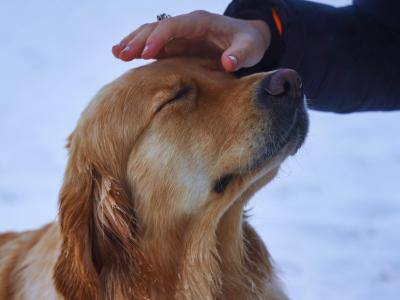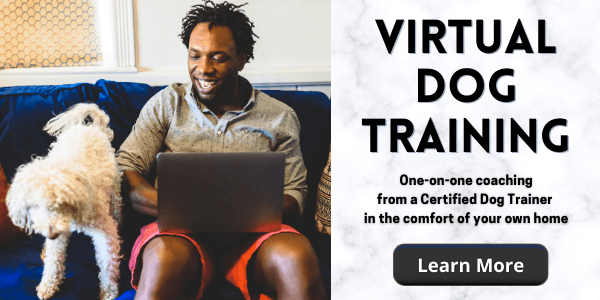 Petting your pup can be reassuring and calming for both of you, but often, our dogs put up with more petting than they actually want.
Petting your pup can be reassuring and calming for both of you, but often, our dogs put up with more petting than they actually want.
Petting our dogs may seem like the most obvious way to show affection for us humans — we have hands, which automatically makes us more "handsy." It's simply a part of how we naturally interact with each other and our environment. But dogs don't have hands. They've learned to accept, and for the most part enjoy, our constant need for touching.
But it's not surprising to see a dog not want to be petted for many reasons. Whether they're just over it and don't want to be disturbed while they rest, or if they're scared or in pain, it's crucial to recognize when a dog doesn't want to be petted.
When a dog's subtle signs that they are uncomfortable aren't noticed or are ignored, the risk of a dog bite increases. Plus, if a dog is scared of being touched or handled, giving them a choice and listening to their body language can do wonders in increasing their confidence.
Signs Your Dog Wants to Be Petted
 Dogs will usually show you when they're in the mood for some cuddles. Look for these signs that indicate your dog is welcoming your touch:
Dogs will usually show you when they're in the mood for some cuddles. Look for these signs that indicate your dog is welcoming your touch:
- Calmly Approaching: Your dog initiating contact on their own is a sign they want the interaction.
- Leaning In: If your dog leans into your hand or body, it’s a good sign they want more petting. This is also when they might indicate a specific area of their body they want pets or scratches.
- Relaxed Body Language: A wagging tail, a relaxed body posture, and a happy facial expression are all cues that your dog is comfortable and content.
- Nudging or Pawing: Sometimes, dogs will nudge your hand with their nose or paw at you to ask for more petting.
Signs Your Dog Doesn't Want to Be Petted
It's equally important to recognize when your dog is not in the mood for physical affection:
- Turning or Leaning Away: If your dog turns their head or body away from you when you try to pet them, they’re probably not interested.
- Heavy Blinking When Hands Approaching: Often seen when reaching over a dog's head, this can mean a dog is uncomfortable with the angle of approach. It can be overwhelming to have petting come from above the head or "patting" of the head, so it's best to avoid this.
- Walking Away: Leaving is an obvious sign your dog doesn't want attention. They may leave the room completely or go and settle somewhere out of reach. If they are on a leash, leaving is no longer an option, so be aware of other signs they are uncomfortable.
- Lip Licking and Yawning: These can be signs of nervousness and discomfort.
- Wide Eyes: Big wide eyes, where you can see the white of the eye, indicate stress. If you see this, your dog likely feels overwhelmed or worried about what's going on.
- Growling or Snapping: These are clear indicators that your dog wants to be left alone and that you should back off immediately.
Read for child safety tips on preventing dog bites.
How to Test Whether Your Dog Wants More Petting
A great way to tell if your dog wants to be petted is to simply ask them! While you can't expect them to verbally tell you what they want, you can perform what's called a consent test before petting and regularly during petting to see if your dog wants pets.
The Consent Test for Petting Dogs
Before starting to pet a dog, make yourself non-threatening by turning slightly to the side and inviting them to come to you with your hands open and by your side or by patting your legs. If they come to you, it's best to pet gently on the chest or shoulder. Avoid reaching over or patting their head, as many dogs don't enjoy this.
Pet for three seconds, then stop and see what they do. If the dog moves closer or nudges your hand for more, they're giving you their consent. If they turn away, stay still, or show no interest in getting more petting, it’s better to respect their wishes and not force further contact.
Use the three-second test during petting, too. Pet for three seconds, then stop and observe their reaction. Always let the dog control the situation when it comes to petting. This helps prevent bites or increased fear of people.
I am always doing the consent test, especially with dogs who aren't my own. But even with my own dogs, I want to make sure I'm not annoying them and respecting their space. I also have my stepson frequently practice consent tests when he's interacting with the dogs. It's heartwarming to see them communicate so clearly without any words.
Here's a wonderful video from Noble Woof showing a consent test:
Why Your Dog Might Not Enjoy Petting
There are several reasons why a dog might not be in the mood for petting.
Pain: If your dog does not like to be petted, the first thing to rule out is pain. Pain is often underdiagnosed in dogs and plays a large role in behavior. Check out these signs your dog might be in pain. If you believe your dog is in pain, see your veterinarian about a variety of ways to help them.
Not in the mood: Just like people, sometimes dogs just aren't in the mood for being touched or interacting with people. They may be tired after a very active day or have other priorities on their mind, such as mealtime or chewing on their toys. In many cases, dogs may exhibit resource guarding behaviors when someone is trying to pet them when they have something they want to enjoy in peace. Don't pet your dog while they are eating or chewing on a dog chew.

Past history: Some dogs have had bad experiences with being touched in the past. This learning history can make them hesitant to allow you or someone else to pet them. If your dog is avoiding petting and medical issues have been ruled out, you can connect with me in a virtual consult to map out a behavior plan to help them feel more confident and comfortable.
Uneasiness: New environments or the presence of strangers could also make them uneasy. Familiarity plays a big role in whether a dog will be comfortable with petting. Just like you may not be comfortable hugging a stranger but totally fine with hugging your family member.
Ideally, your dog could build some confidence with patience, compassion, and training support. But it's important to remember that there is no reason your dog has to be petted by unfamiliar people. It's always okay to tell someone no when they ask to pet your dog. In fact, I recommend practicing it with all dogs for both their training and to help people have realistic expectations.

Understanding and respecting your dog's comfort level with physical affection is important. It not only strengthens the bond between you and your dog but also ensures safety. Non-consensual petting can lead to stress and anxiety in dogs, potentially escalating to aggression and bites. Teaching children to recognize and respect a dog's signs of consent is especially crucial for preventing unfortunate incidents and for their safety around dogs. Learn more about how to prevent dog bites to children here.
Every dog is an individual with its own preferences and boundaries, just like people. Respecting those boundaries is the foundation of a loving and trusting relationship.




